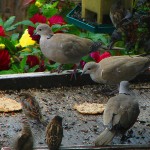 In early October 2011 was the first time that a Eurasian Collared Dove had visited my bird feeder, I quickly grabbed my camera and took some pictures. Previously I have seen this bird and it was added to my “Life List” on December 29, 2007, where he was sitting on a power line just south of Oliver, British Columbia.
In early October 2011 was the first time that a Eurasian Collared Dove had visited my bird feeder, I quickly grabbed my camera and took some pictures. Previously I have seen this bird and it was added to my “Life List” on December 29, 2007, where he was sitting on a power line just south of Oliver, British Columbia.
In checking on this bird, I found that was no inclusion in the 1987 “Birds of the Okanagan Valley, British Columbia” and when you look at the “National Geographic Field Guide to the Birds of North America” it shows the range of the US Gulf States of Florida, Louisiana, Texas, etc. Next I went to the Audubon Christmas Bird Count (for British Columbia) results to look at the historical data, which first began in 2003-04 when 25 individuals were reported and has grown to 682 in 2009-10.
Obviously we have a case of a new species now present outside of its traditional range. In fact the Eurasian Collared Dove isn’t native to North America but was introduced to this continent in the 1970s. Since then it has widely dispersed and we now enjoy them in British Columbia. The reason that we have been seeing them on the Christmas Bird Count is that they do not migrate.
As these birds expand their range in North America, it will be interesting to observe the impact of this introduced species on populations of native birds, in particular how will this population explosion will impact the native Mourning Dove, and to learn what ecological/geographical barriers finally limit their range expansion.
To learn more about British Columbia’s diverse birds see Great Horned Owl Eco Tours.



Hi Pierre
Since moving into my neighborhood 2 years ago the Eurasian Collared Doves must really like it here; their numbers have mushroomed. When I walk each day around the area I can easily count 10 Doves in 1/2 hour. They have become very dominant, one becomes very accustomed to their calls, one of the calls reminds me of a Great Horned Owl. You could very well be right about possibly displacing Rock Doves and even Mourning Doves.
Greg
This is a very interesting post: I have been living on Vancouver’s north shore for two years now and in the last two summers, I thought I heard a bird that sounded oddly like a dove that I heard regularly in France when I lived there for a couple of years in the 90s. But I thought I was imagining things. Then this summer, I started hearing and seeing the ECDO everywhere… I’m guessing that they had a few successful breeding seasons and are now firmly entrenched here. And even though they are an introduced species, I must say that they are far more appealing to me than their cousins, the Rock Dove.
Hello Greg,
I was tickled to see your article about the Eurasian Collared Dove. Last spring, I began hearing a new bird sound in my neighbourhood. I live in a somewhat woodsy central Oregon coastal area, on a creek that connects with the ocean, about a half-mile away. I enjoy birds but have never become an ‘official’ bird watcher, though I have a few apps on my iPad. I am particularly fond of bird songs. I could never spot the bird so I tried to match it with sounds of birds in the area, including water birds. Nothing quite matched but I narrowed it down to a dove-like or owl-like sound. Then, after several weeks, this dove suddenly flew to a branch on a tree right beside me, looked me right in the eye, then flew away. Naturally, I didn’t have my camera with me. It was then I began listening to various other dove sounds on my apps and discovered that my friend was indeed, the Eurasian Collared Dove. I know there were at least two of them since there would sometimes be an echoing return call. I would hear the birds early morning and again in the evening on a regular basis, with occasional calls at other times, but I only spotted the one bird that one time. About six weeks ago, the calls ended completely and I do miss them. I was glad to see your article and to find out that they were not ‘lost’ but just broadening their horizons. I can only hope they moved on to something better and are still safe and thriving.You said they don’t migrate so I have wondered. I would love to get up there (where life makes more sense) and enjoy some of Canada’s lovely birds. ;>) In the meantime, thanks for your nice articles. — J Rose